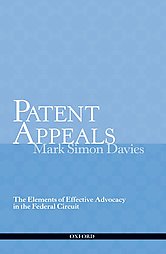
Not being an appellate lawyer, I was hesitant to review a book on such a specialized topic. Patent prosecution and transactional lawyers tend to steer clear of arcane rules regarding what size font to use in a brief and debating whether it would be better to use serif or sans serif. But I gave it a read after deciding that all patent work is about obtaining patent protection that is ultimately found to be both infringed and valid. In the end, that means getting past any final review at the Fed Circuit.
Like it sounds, the book covers the nitty-gritty regarding the organizational requirements for an appellate brief. However, along the way the author provides some insight on the informal expectations and special challenges presented by a patent appeal. Each chapter contains general advice on how to prepare a certain section of the brief — from Statement of the Facts to Summary of the Argument — along with samples and some inside tips. The book also covers post-briefing issues, petitions for panel rehearing and rehearing en banc as well as advice on hiring appellate co-counsel.
What’s important is that the author sets out the new dynamic of patent law where the Federal Circuit is under intense scrutiny by the Supreme Court. Between 1998 and 2005, the Supreme Court took up ten cases (10 of 502 or double the historic average) and reversed in 9 of 10 of these cases. The take-home message is that everything has to be geared as though addressed to the Supreme Court and the author urges avoiding reliance on any kind of Federal Circuit test. From eBay v. Mercexchange to KSR Int’l Co. v. Teleflex Inc., the Supreme Court has shown time and again that it just doesn’t think much of the Fed Circuits cute little tests. In KSR, the justices show their disdain in a protracted exchange:
Chief Justice Roberts: “It adds a layer of Federal Circuit jargon that lawyers can then bandy back and forth, but if it’s — particularly if it’s nonexclusive, you can say you can meet our teaching, suggestion, or motivation test or you can show that it’s nonobvious, it seems to me that it’s worse than meaningless because it complicates the inquiry rather than focusing on the statute.”
Goldstein: “Mr. Chief Justice, the reason that the Federal Circuit disagrees and over 30 years this special court has elaborated this problem – is that we need a guidance, we need guidance for the lower courts. We need to focus them on the right question, and for patent examiners and patent practitioners, and the right question is not is — was someone merely capable of putting the two together. The right question is is there any reason to believe that it would have been apparent at the time of the invention to create this invention whether it’s through a teaching, a suggestion, a motivation.”
Justice Scalia: “I agree with the Chief Justice. It is misleading to say that the whole world is embraced within these three nouns, teaching, suggestion, or motivation, and then you define teaching, suggestion, or motivation to mean anything that renders it nonobvious. This is gobbledygook. It really is, it’s irrational.”
Practice tip: avoid reference to any test.
Mark Simon Davies is a counsel in O’Melveny & Myers LLP’s Washington, D.C. office. He has argued more than twenty-five cases, including Festo Corp. v. SMC, Corp., Fed. Cir. No. 95-1066 (en banc), and Southco Inc. v. Kanebridge Corp., 3d Cir. 02-1243 (en banc).
Patent Appeals: The Elements of Effective Advocacy in the Federal Circuit

[…] last week, Albainy-Jenel wrote a book review (of “Patent Appeals: The Elements of Effective Advocacy in the Federal Circuitâ€Â by Mark Simon […]